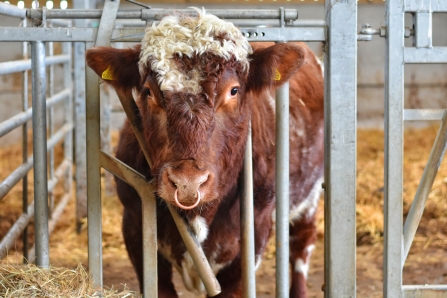
Jupiter. (c) Marianne Fairclough
Crocus. (c) Marianne Fairclough

Jupiter. (c) Marianne Fairclough
This is Jupiter. He is our pure-bred Beef Shorthorn bull and came to us in May. When he arrived, we had to quarantine him for 1 month before he could meet the herd to make sure that he was healthy and didn’t have any signs of disease that he could pass on to the others. He is 3 years old and is still a little nervous of us as he’s still getting used to a new farm and lots of new faces. He loves a treat of alfalfa though and will tend to let us give him a bit of a scratch behind the ears when he has his head in the bucket!
Like most bulls, Jupiter is a big lad and weighs in at around 800kg. All bulls should be approached with caution as they are big animals who can move surprisingly fast. At the farm we try to ensure that signs are clearly displayed to let everyone know if Jupiter is in a certain field and keep him clear of popular walking routes.
Jupiter will be with us for the next 2 years until it is time for him to move on to another farm. Bulls often move round after 2-3 years as this ensures that he does not breed with his descendants. This year he has successfully managed to get all of our breeding cows and heifers pregnant which means we will hopefully have 16 new calves in the spring which is fantastic!

Ladybird. (c) Marianne Fairclough
This is Ladybird. She is our oldest and heaviest cow weighing in at an impressive 800kg. She is due to have her 10th calf in the spring and has been with Stirley since the start in 2011. She has tended to take the matriarch role in the herd until the summer when she injured one of her hooves on the dry ground.
After this, Number 9 aka Crocus who you will meet shortly has seemed to take over as boss. No one messes with Ladybird though and she tends to get what she wants, even Crocus doesn’t stop her! A quiet, steady cow, she has produced some beautiful healthy calves and is a vital component of the herd.

Crocus. (c) Marianne Fairclough
Crocus– Noisy nosey number nine! I do have a bit of a soft spot for this cow as she is full of character and always happy to have a bit of a scratch and a fuss made of her. She is a very dominant cow in the herd and will tend to lead the group when called by us while making a lot of noise! She, like Jupiter loves an alfalfa treat and will race to be the first at the bucket.
We have to be careful that she doesn’t get carried away as she sometimes forgets how boisterous she is! In the spring she will be expecting her 5th calf and has been with Stirley since 2013. Here’s hoping her next calf has the same friendly temperament and impressively big ears as she does! Just look at them!

Jumana. (c) Marianne Fairclough
Jumana is one of our 3 year old heifers which means that she is a young female cow that has yet to have her first calf. Heifers tend to be around 3 years old when they have their first calf. As you can see, Jumana is all white while the rest of our gang are a mixture of red and roan (mixture of red and white). Being all white means that we will hopefully keep a good mixture of colours in our herd.
As a first time calver we will be keeping a close eye on her to make sure everything goes smoothly and when calving starts, we will have experienced checkers on around the clock.

Myrtle. (c) Marianne Fairclough
This is Myrtle who was born in April last year. She is the daughter of Crocus and will hopefully go on to become one of our breeding cows. At the moment she is being weaned which means that she is no longer getting nutrients from her mother’s milk but from hay instead.
She is currently housed with the rest of the calves in clear site of their mothers. In the spring she will be turned out with the rest of the herd and spend the next 18 months exploring the fields and putting on weight. We will get to know a bit more of her personality as she fits in as one of the teenagers before being put to the bull in 2020.

Karolina. (c) Marianne Fairclough.
We breed Beef Shorthorn cattle which means that we do slaughter some of our animals for meat production. Karolina will be one of those that go to slaughter this year.
She is a heifer and would have normally been kept on as a breeding animal but unfortunately, she has an infection called Neospora. This infection is not contagious between healthy adult animals or between animals and humans so the meat they produce is safe for human consumption but can cause devastating effects if an infected animal becomes pregnant. The infection can cause abortion or still born calves and is picked up by cows when they graze as it is commonly spread by dogs which can be a problem at Stirley as there are many public foot paths. I will go into this in more detail at a later date and highlight how you can help to stop the spread.